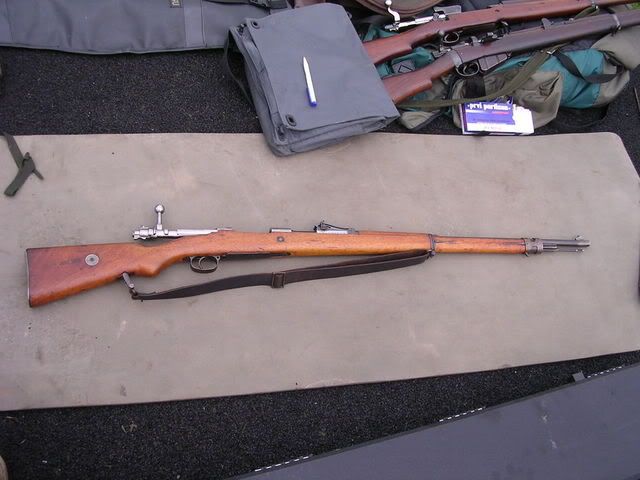Has to be a German Mauser as used in Boer war!!!!!

But then again I am slightly biased! :cheers:
http://en.wikipedia.org/wiki/Second_Boer_War
http://www.heliograph.com/trmgs/trmgs4/boer.shtml
Armaments of the Boer and British forces
As a regular army, the British force followed a more standard pattern in terms of equipment. Primarily, their infantry weapons were the Lee-Metford and Lee-Enfield rifles. Lee, a Canadian of Scots descent, toured Europe in 1880, provoking interest in his idea from several nations including the Danish, and eventually convinced the British Ordnance Bureau to adopt his system. Combined with the Metford rifling system, the subsequent weapon was named the Lee-Metford; in 1888, its magazine capacity was upgraded to eight rounds of .303 caliber (7.69mm). Various features of the Lee-Metford meant that it weathered the abuse of soldiering less well than these other rifles; for this reason it was upgraded in 1895 to its sturdier incarnation - the Lee-Enfield. Apart from some changes in breech architecture and rifling, these two weapons were very similar, and can be treated as one weapon for tactical analysis.
The adoption of the Lee series ran simultaneously with the development of two other significant firearms of the period; the Mauser, which was developed in 1888 and refined in 1898, and the Danish Krag-Jorgenson. These two weapons were used extensively by the Boers, and provided them with equivalent firepower to the British; the Mauser used slightly heavier bullets (.317 caliber, or 7.92mm) and fast-moving (777 m/s compared to 607 m/s) than the Lee-Metford, with a subsequent increase in the potential severity of wounds inflicted. Additionally, the Mauser had more slightly elaborate sights; graded out to 2000 meters compared to the 1829 meters of the Lee-Metford, this meant that the Mauser was more likely to perform better at long-range shooting than the Lee-Metford.
The infantry were also equipped with the 12-inch sword bayonet. This fearsome weapon was itself a relic of the days of musketry; its presence on a weapon which could be fully reloaded in a matter of seconds was an indicator of the degree to which British tactical thought had not yet fully grasped the impact of the magazine rifle. Weighing over a pound (15 ounces), it must have been cursed by many a over-burdened British soldier; however, its psychological impact was, as was no doubt intended, great. When the cry of "Fix Bayonets!" was heard, several accounts describe Boer surrender as an immediate consequence. The same can be said of the famous cavalry lance. Lancers, while also equipped with the Lee-Enfield carbine, were feared in close quarters, primarily because of the terror value associated with being skewered by their lances.
It should be noted that while uniformity was the general watchword regarding British armaments, that this was not the case in all circumstances. The Canadian forces, for instance, were armed differently, many with weapons of American manufacture such as Colt .45 revolvers (which were the standard side arms of the US at that time), as well as Lee-Enfields.
Boer small arms, on the other hand, varied considerably.
Mauser, Martini-Henry and Krag-Jorgenson (shown alongside) rifles were all employed, as well as a variety of personal hunting rifles and other weapons. An excerpt from a British army surgeon's diary shows that Boer forces also used shotguns; this is entirely likely, given that Boer recruitment advised burghers to bring their own "…Rifle, ammunition, Horse, saddle and bridle, [and] food for eight days" to their mustering point. Rural as the Boer population was, it is unlikely that every man had access to a rifle of sufficient caliber as to be useful; many, then, would have brought whatever they could lay their hands on. A similar pattern has been seen wherever armies have been raised from local populations; most notably, in the American War of Independence. The governments of the Boer Republics also purchased weapons in bulk from overseas nations, in particular Germany. Some efforts were made to distribute these weapons among the troops, although most were held in reserve for arming sympathetic rebels in captured territories. It is likely that the nature of the Boer force, with its emphasis on marksmanship which had been learnt through experience and not as the result of training, precluded the adoption of a standard rifle. Throughout the war, of course, and especially during the guerilla phases where resupply was no longer a possibility, many Boers took to using captured British weapons. Ammunition for these weapons could be stolen or captured, and although the weapons themselves were less than ideal for the natural born marksman, they were better than none at all.


